
Vincenzo Scamozzi was an Italian architect and a writer on architecture, active mainly in Vicenza and Republic of Venice area in the second half of the 16th century. He was perhaps the most important figure there between Andrea Palladio, whose unfinished projects he inherited at Palladio's death in 1580, and Baldassarre Longhena, Scamozzi's only pupil.

Andrea Palladio was an Italian Renaissance architect active in the Venetian Republic. Palladio, influenced by Roman and Greek architecture, primarily Vitruvius, is widely considered to be one of the most influential individuals in the history of architecture. While he designed churches and palaces, he was best known for country houses and villas. His teachings, summarized in the architectural treatise, The Four Books of Architecture, gained him wide recognition.

The Brenta is an Italian river that runs from Trentino to the Adriatic Sea just south of the Venetian lagoon in the Veneto region, in the north-east of Italy.

Villa Foscari is a patrician villa in Mira, near Venice, northern Italy, designed by the Italian Renaissance architect Andrea Palladio. It is also known as La Malcontenta, a nickname which—according to a legend—it received when the spouse of one of the Foscaris was locked up in the house because she allegedly did not live up to her conjugal duty.

Villa Pisani at Stra refers to the monumental, late-Baroque rural palace located along the Brenta Canal at Via Doge Pisani 7 near the town of Stra, on the mainland of the Veneto, northern Italy. This villa is one of the largest examples of Villa Veneta located in the Riviera del Brenta, the canal linking Venice to Padua. The patrician Pisani family of Venice commissioned a number of villas, also known as Villa Pisani across the Venetian mainland. The villa and gardens now operate as a national museum, and the site sponsors art exhibitions.

Actv S.p.A. is a public company responsible for public transportation in Venice and Chioggia municipalities and for interurban bus services in province of Venice. ACTV is not responsible for Venice People Mover and waterbus routes between airport and the lagoon area. Connections by bus with Venice airport are managed by ACTV and by ATVO.

Dolo is a town and comune in the Metropolitan City of Venice, Veneto, Italy. It is connected by the SP26 provincial road and is one of the towns of the Riviera del Brenta.

Fiesso d'Artico is a town in the Metropolitan City of Venice, Veneto, Italy. The town is connected by the SR11, and is part of the Riviera del Brenta.
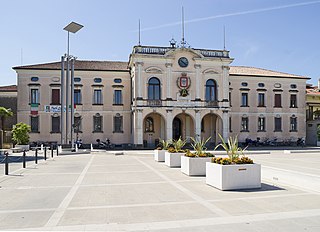
Mira is a comune (municipality) in the southern Veneto, northern Italy. It is part of the Metropolitan City of Venice and the 11th most populous comune of Veneto.
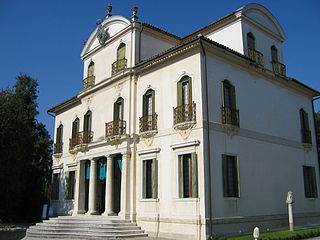
The Villa Widmann, also called Widmann-Rezzonico-Foscari, is a villa at the shores of the river Brenta located in the small town of Mira, between Venice and Padua.

Andrea Tirali was an Italian architect working in Venice and the Veneto. He was responsible for the intricate design of the pavement in the Piazza San Marco in Venice.
The Walls of Padua are a complex of defensive works around the Italian city of Padua, designed to defend it from hostile attack. It was built in 4 phases.

The Venice Marathon is a marathon road race that has been held each year in Venice since 1986, usually in October. The course starts in Stra and passes through Mestre, Parco San Giuliano, and Ponte della Libertà before ending at Riva dei Sette Martiri in Venice. The marathon is categorized as a Bronze Label Road Race by World Athletics.
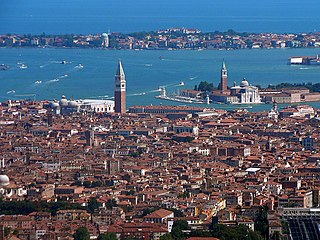
The Metropolitan City of Venice is a metropolitan city in the Veneto region, Italy, one of ten metropolitan cities in Italy. Its capital is the city of Venice. It replaced the Province of Venice in 2015 and includes the city of Venice and 43 other municipalities (comuni). It was first created by the reform of local authorities and then established by Law 56/2014. The Metropolitan City of Venice is headed by the Metropolitan Mayor and the Metropolitan Council. Since 15 June 2015, as the new mayor of the capital city, Luigi Brugnaro is the first mayor of the metropolitan city.
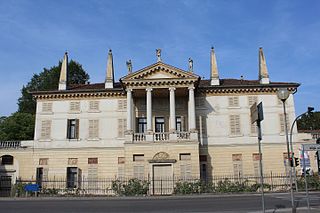
Villa Foscarini Rossi is a Baroque-style aristocratic rural palace located at Via Doge Pisani 1/2, along the Riviera del Brenta, at Stra on the mainland of the Veneto, northern Italy. The Villa now houses a museum of shoes.
The Foscari were an ancient Venetian patrician family.
This is an alphabetical index of people, places, things, and concepts related to or originating from the Republic of Venice. Feel free to add more, and create missing pages.

The Venetian patriciate was one of the three social bodies into which the society of the Republic of Venice was divided, together with citizens and foreigners. Patrizio was the noble title of the members of the aristocracy ruling the city of Venice and the Republic. The title was abbreviated, in front of the name, by the initials N.H., together with the feminine variant N.D.. Holding the title of a Venetian patrician was a great honour and many European kings and princes, as well as foreign noble families, are known to have asked for and obtained the prestigious title.
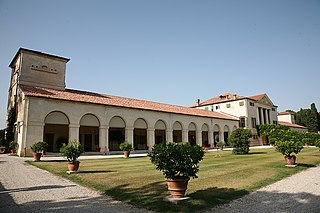
A barchessa is a rural service building, typical of the architecture of Venetian villas. The concept was created and popularized by architect Andrea Palladio. A barchessa contains the working portions of the estate, separately from the central body of the villa. Barchessas were characterized by a long arcade with high round arches and used for services including kitchens, farm staff, stables, and barns. As interpreted outside of Italy, the barchessas evolved to become defining elements of Palladian architecture.





















